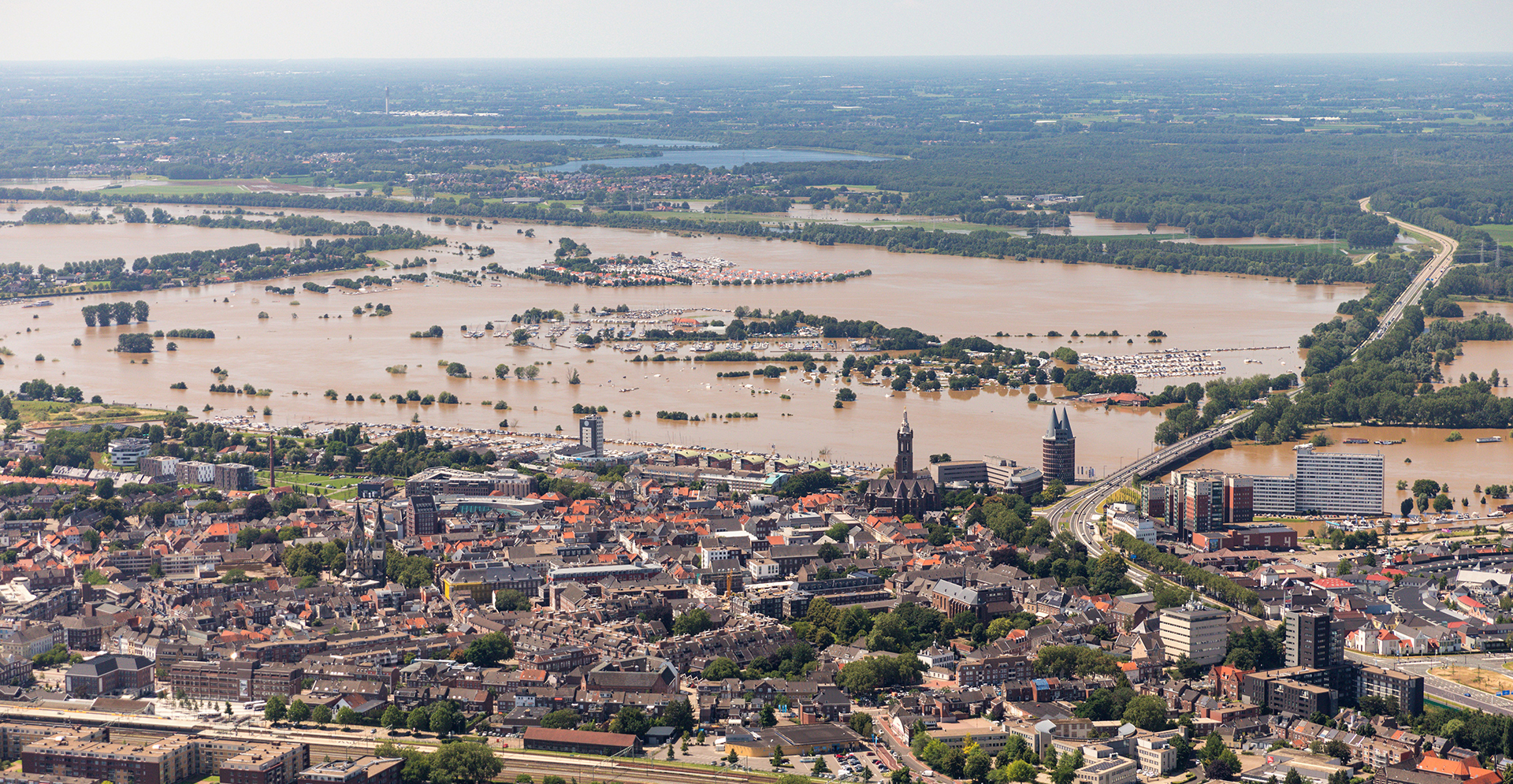This past week, record rainfalls and unprecedented flash flooding were witnessed across Western Europe, causing catastrophic damage in Belgium, Germany and the Netherlands. Although scientists are hesitant to say whether the flooding was caused by climate change, we recognize that the climate crisis has increased the probability of these events and made extreme weather conditions worse.
More rain fell in a couple of hours than would usually be seen over the entire month of July. Riverbanks burst and flood defenses failed. Entire communities were inundated, leading to mass evacuations, damage to critical infrastructure, interrupted services, and, unfortunately, many deaths. Even in the Netherlands, a country that is world-renowned for its flood defense capabilities, the national government declared a state of disaster for the southern Province of Limburg.
To understand more about what happened and what can be done to better prepare for and respond to catastrophic events like this in the future, we spoke with our Global Solutions Lead for Resilience and Water Management, Piet Dircke. Piet has more than 35 years of experience in water management and major flood resilience projects all over the world.
Piet, how could there be such extensive flooding in the Netherlands, given all the time, money, and attention that’s been devoted to putting infrastructure in place to prevent this from happening?
The rainfall that Europe experienced last week was truly exceptional. Since we started measuring, we have only seen a similar rainfall event on two other occasions and both were during the winter, not during summer. Though the intensity and scale of the flooding last week was enormous and unexpected, overall, the flood protection measures in the Netherlands worked well, in particular along the big rivers. With the Maaswerken along the River Meuse, and the Room for the River Program carried out along the other large Dutch rivers, water levels could be controlled, and the damage was limited. There is no doubt that there was substantial damage done, but relatively speaking, the Dutch were well-protected and prepared. As it stands now, it appears that no lives were lost, here in the Netherlands.
If those flood protection measures in the Netherlands worked, for the most part, why did we see such an upheaval in the southern part of the country?
The heavy rains across Limburg and the Ardennes caused the southern tributaries to the Meuse River, such as the Roer, Geul and Gulp, to fill quickly which led to severe flooding in river towns like Roermond, Valkenburg, and Slenaken. These tributaries are not part of the Dutch national flood protection program, and therefore they have lower protection levels than what we have put in place along the Meuse.
In addition to the lower protection levels, these towns as well as other towns along the River Meuse also lost vital and critical public infrastructure like electricity and public transport. Also, public facilities like hospitals and nursing homes were not always planned in the right places, so some of them were not well protected and resilient enough to withstand the water.
Piet, you live in Limburg, one of the regions hit with flooding. In fact, you own home was flooded. Can you talk about what you experienced?
In my own house in the City of Maastricht, the water, unfortunately, came from the overloaded combined sewer system via the toilet and flooded our master bedroom. We had to get rid of the carpet are still waiting for everything to dry out. Thankfully, our family in the area was able to come help us, while I had to concentrate on my work. Strong community support is a significant factor in helping people recover quickly from these types of events. Cities truly are only as resilient as their citizens, so tight knit communities, where people check in on each other and support each other through events like this, are fundamental to resilience.
Some scientists are saying that this disaster is a clear sign that the climate crisis is upon us, we’re unprepared for it and it’s time for drastic measures. Isn’t it time for you and people living where you live to move out of these areas that will be subject to these types of events with increased frequency?
Throughout my life and career, I have seen signs that the climate is changing. And it is true that many of the proactive preparations that need to be taken to meet this challenge have fallen short. People often tend to only notice the danger, and take action, once it is at our doorstep. But I don’t think this is necessarily the time to give up and retreat, nor stick our heads in the sand. Many of our cities are on the front line of the climate crisis, meaning our livelihoods, history, and culture are too. The time for action is now. We need to change the default and reactive nature of our responses, and instead, anticipate and prepare for things we know will happen in the future but also for the unknown. Let’s take up this challenge and drive innovation and radically change how we deal with the impacts of climate change. This challenge can drive collaborative action and new relationships. It’s an opportunity to rethink and invest in the resilience of our societies and communities.
What lessons are you learning from this disaster, how will this inform your work going forward and what can companies like Arcadis do to help prevent this in the future?
Given the future impacts and uncertainties of climate change, we need to strengthen our flood protection systems even more, and create more room for water. At the same time, we need to make our most critical and vital infrastructure more robust to avoid power failures, blocked transportation systems that limited access as well as evacuations, and other disruptions that interfere with recovery efforts. Last but not least, I noticed that during this flood event, a significant part of the rescue efforts had to be focused on vulnerable people in public facilities like hospitals and nursing homes. Many patients needed to be evacuated from the hospital in the City of Venlo, while the hospital in Maastricht was inaccessible for a while. Just imagine how many hands would be freed up if the public buildings, where these people were trapped, were developed with more resilience in mind. Think about how this could help accelerate recovery efforts.
Fundamentally, the biggest lesson is, resilience pays off. Resilience means keeping cities livable, and improving that livability, even when shocks and stressors impact them. When we invest in resilient buildings and critical infrastructure, they can continue to function and provide vital services to the public even in challenging times. Recovery efforts can be more efficient, and people can return to their lives quicker and having suffered less stress. Though disasters cannot always be prevented, by investing in resilience, cities and communities can become more capable of coping with and rebounding from these types of events.
For us at Arcadis, I think it’s important that we continue tapping into our deep knowledge and know-how around resilience, because the world needs this now more than ever. Collectively, we have to do a much better job of protecting our critical infrastructure and this is where Arcadis can help. For example, just look at the great work we are doing in New York City, after Hurricane Sandy, hardening hospitals against storm surge flooding and enhancing coastal resilience in Lower Manhattan. These techniques need to be employed in cities all around the world to protect people from extreme weather events in the future.






